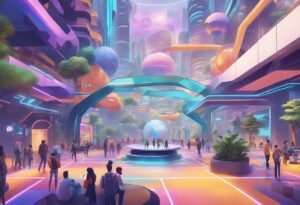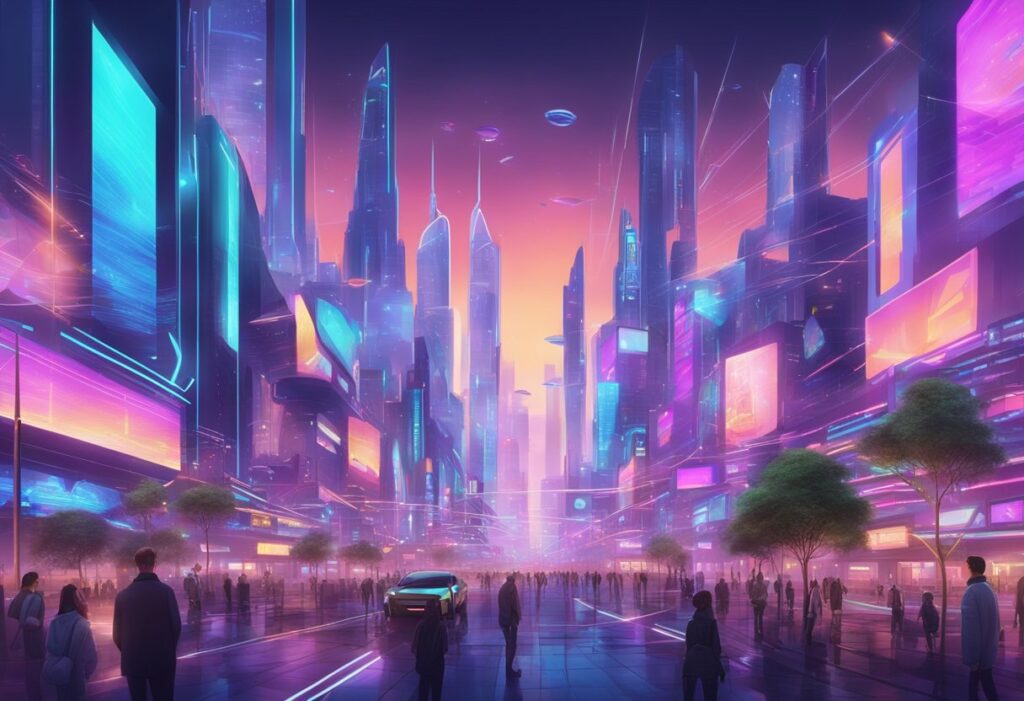The concept of a metaverse, a virtual reality space where people can interact with each other and digital objects, has been around for decades. However, recent advancements in technology have made it possible to create more immersive and interactive metaverse experiences. One aspect of the metaverse that is crucial to its success is the quality of its graphics. Without high-quality graphics, the metaverse experience can feel flat and unengaging.
As the metaverse becomes more prevalent, the demand for high-quality graphics will only increase. This demand will drive advancements in graphics technology, such as better rendering engines and more powerful GPUs. The rise of augmented reality (AR) and virtual reality (VR) technologies will also contribute to the development of metaverse graphics. These technologies will allow users to interact with digital objects in the metaverse in more natural and intuitive ways.
The future of metaverse graphics looks promising. As technology continues to improve, the metaverse will become more immersive and engaging, providing users with a truly unique and interactive experience. With the right combination of technology and creativity, the metaverse has the potential to revolutionize the way we interact with each other and the digital world.
Foundations of Metaverse Graphics
Metaverse graphics is a rapidly evolving field that involves creating virtual worlds that are immersive and interactive. The field has its roots in computer graphics, which has been around for several decades. However, the advent of VR and the internet has led to a significant increase in the popularity and importance of metaverse graphics.
Evolution of Virtual Worlds
Virtual worlds have come a long way since their inception. They started as simple text-based games and have evolved into complex 3D environments that are almost indistinguishable from the real world. The development of hardware such as GPUs and VR headsets has played a significant role in this evolution.
The development of cloud computing has made it possible to create massive virtual worlds that can be accessed by millions of people at the same time.
Core Technologies and Hardware
Metaverse graphics relies on a range of core technologies and hardware to create immersive and interactive virtual worlds. One of the most critical technologies is 3D modeling, which involves creating the structure and shape of objects and spaces in the virtual world. Texturing is another important technology that adds realism by applying surface details and materials.
Hardware such as GPUs is also critical to metaverse graphics. GPUs are specialized hardware that is designed to handle complex graphics calculations quickly and efficiently. VR headsets are also essential as they allow users to immerse themselves in the virtual world and interact with it in a more natural way.
Metaverse graphics is an exciting field that is rapidly evolving. Its foundations lie in computer graphics, but the development of VR, the internet, and hardware such as GPUs and VR headsets has led to significant advancements. Core technologies such as 3D modeling and texturing are critical to metaverse graphics, as are hardware such as GPUs and VR headsets.
Creating the Metaverse Experience
To create an immersive experience in the metaverse, designers must focus on several key aspects, including 3D modeling and rendering, realism, and procedural generation.
3D Modeling and Rendering
One of the most important aspects of creating an immersive metaverse experience is 3D modeling and rendering. This involves creating realistic avatars, environments, and objects that users can interact with. Designers must carefully consider the lighting, textures, and materials used in their models to ensure a realistic and immersive experience.
Realism and Procedural Generation
Realism is another crucial aspect of the metaverse experience. Designers must aim to create environments and objects that are as close to reality as possible.
This involves using advanced rendering techniques, such as ray tracing, to create realistic lighting and shadows. Designers can use procedural generation to create environments that are unique and dynamic. This technique involves using algorithms to generate landscapes, buildings, and other objects, resulting in a more immersive experience for users.
Creating a successful metaverse experience requires a careful balance of art and technology. By focusing on 3D modeling and rendering, realism, and procedural generation, designers can create immersive and engaging environments that users will love to explore.
Interactivity and User Engagement

Metaverse graphics require a high degree of interactivity to create an immersive user experience. Users expect to engage with the virtual world, and this requires designers to consider a wide range of factors, including social interaction, collaboration, user experience, and accessibility.
Social Interaction and Collaboration
Social interaction and collaboration are critical components of metaverse graphics. Users want to feel like they are part of a community and have the ability to interact with others in real-time. This requires designers to consider the social dynamics of the virtual world and create environments that encourage social interaction and collaboration.
User Experience and Accessibility
User experience and accessibility are also essential factors to consider when designing metaverse graphics. Motion graphics and other visual effects can be used to create a more engaging user experience, but designers must also consider accessibility issues such as color contrast and font size. Designers must consider the needs of users with disabilities and ensure that the virtual world is accessible to everyone.
Metaverse graphics require a high degree of interactivity and user engagement to create an immersive user experience. Designers must consider a wide range of factors, including social interaction, collaboration, user experience, and accessibility, to create environments that are both engaging and accessible to all users.
Metaverse Platforms and Ecosystems

Virtual Economies and Digital Assets
The rise of metaverse platforms has led to the creation of virtual economies and digital assets. These economies are based on the exchange of virtual goods and services, which can be bought, sold, and traded using digital currencies. The most notable digital currency used in these economies is cryptocurrency.
Meta, the parent company of Facebook, has recently announced its plans to create a metaverse platform that will allow users to interact with each other in a virtual world. The platform will also allow users to buy, sell, and trade virtual goods using cryptocurrency.
Horizon Worlds is another metaverse platform that allows users to create their own virtual worlds and experiences. The platform has its own economy, which is based on the exchange of virtual goods and services. Users can earn cryptocurrency by creating and selling virtual goods on the platform.
Decentraland is a blockchain-based metaverse platform that allows users to create, experience, and monetize their own virtual worlds. The platform has its own digital currency, MANA, which is used to buy, sell, and trade virtual goods and services.
Notable Metaverse Examples
VRChat is a popular metaverse platform that allows users to create and share their own virtual worlds and experiences. The platform has a large user base and supports a variety of virtual reality devices.
Roblox is a gaming platform that has a metaverse component. The platform allows users to create and share their own games and experiences. The platform also has its own economy, which is based on the exchange of virtual goods and services.
The Sandbox is a blockchain-based metaverse platform that allows users to create and monetize their own virtual worlds. The platform has its own digital currency, SAND, which is used to buy, sell, and trade virtual goods and services.
Cryptovoxels is a blockchain-based metaverse platform that allows users to create and own virtual land. The platform has its own digital currency, Voxels (VOX), which is used to buy, sell, and trade virtual land.
Nike and RTFKT are examples of companies that have entered the metaverse space. Nike has created virtual sneakers that can be worn in metaverse platforms, while RTFKT creates and sells virtual sneakers and other digital fashion items.
Metaverse platforms have led to the creation of virtual economies and digital assets. These economies are based on the exchange of virtual goods and services, which can be bought, sold, and traded using digital currencies. Notable metaverse examples include Meta, Horizon Worlds, Decentraland, VRChat, Roblox, The Sandbox, Cryptovoxels, Nike, and RTFKT.
Ethical and Technical Challenges
Security, Privacy, and Intellectual Property
The metaverse presents significant challenges to security, privacy, and intellectual property. The digital nature of the metaverse means that it is susceptible to hacking, data breaches, and other security threats. This could potentially lead to the theft of intellectual property, such as 3D models and other digital assets. To mitigate these risks, companies developing the metaverse need to prioritize security and privacy measures.
One way to enhance security is to implement encryption and other security protocols to protect user data and intellectual property. Companies should establish clear guidelines and policies for the use of intellectual property in the metaverse. This includes protecting the rights of creators and ensuring that their work is not used without proper attribution or compensation.
Interoperability and Standards
Another challenge facing the metaverse is interoperability and standards. The metaverse is a complex and diverse ecosystem, with different platforms, technologies, and content formats. This can make it difficult for users to move between different metaverse environments and share content seamlessly.
To address this challenge, the industry needs to establish universal standards and protocols for the metaverse. One such standard is the Universal Scene Description (USD), which is an open-source format for describing 3D scenes and models.
By adopting standards like USD, companies can improve interoperability and make it easier for users to share content across different metaverse environments.
The metaverse presents significant ethical and technical challenges that must be addressed by the industry. By prioritizing security, privacy, and intellectual property, and establishing universal standards and protocols, companies can create a more secure, interoperable, and user-friendly metaverse for everyone.
Frequently Asked Questions
How do graphics in the metaverse enhance user experience?
Graphics in the metaverse play a crucial role in enhancing the user experience. They create a sense of immersion and allow users to engage with the virtual world in a more meaningful way. High-quality graphics can make the metaverse feel more realistic, and this can lead to increased engagement and a more enjoyable user experience.
What technologies are driving the realism in metaverse graphics?
Several technologies are driving the realism in metaverse graphics. These include advanced rendering techniques, such as ray tracing, which can create more realistic lighting and shadows.
Other technologies include machine learning, which can be used to generate more detailed textures and models, and virtual and augmented reality, which can create a more immersive experience for users.
Can graphics in the metaverse impact its economic potential?
Yes, graphics in the metaverse can have a significant impact on its economic potential. High-quality graphics can attract more users and create a more engaging experience, which can lead to increased spending on virtual goods and services. This can create new opportunities for businesses and individuals to monetize their creations in the metaverse.
What are the challenges in creating high-quality graphics for the metaverse?
Creating high-quality graphics for the metaverse can be challenging due to the complexity of the virtual world. One of the biggest challenges is optimizing graphics for different devices and platforms, as users may access the metaverse from a variety of devices with varying performance capabilities.
Creating realistic graphics can be time-consuming and resource-intensive, and there may be limitations in the technology available to developers.
How do metaverse graphics compare across different platforms like Decentraland and Meta Horizons?
Metaverse graphics can vary significantly across different platforms, as each platform may have its own unique set of tools and technologies for creating and rendering graphics.
Decentraland, for example, uses a decentralized approach to graphics rendering, while Meta Horizons uses a more centralized approach. Ultimately, the quality of graphics in the metaverse will depend on the resources available to developers and the specific needs of each platform.
What role does cryptocurrency play in the development of metaverse graphics?
Cryptocurrency plays a significant role in the development of metaverse graphics, as it can be used to incentivize developers and creators to contribute to the virtual world.
Cryptocurrencies like Bitcoin and Ethereum can be used to buy and sell virtual goods and services in the metaverse, and they can also be used to reward developers for creating high-quality graphics and other content. This can create new opportunities for developers and creators to monetize their contributions to the metaverse.














